Dragonfly Doji: Definition, Structure, Trading, Examples, and Advantages
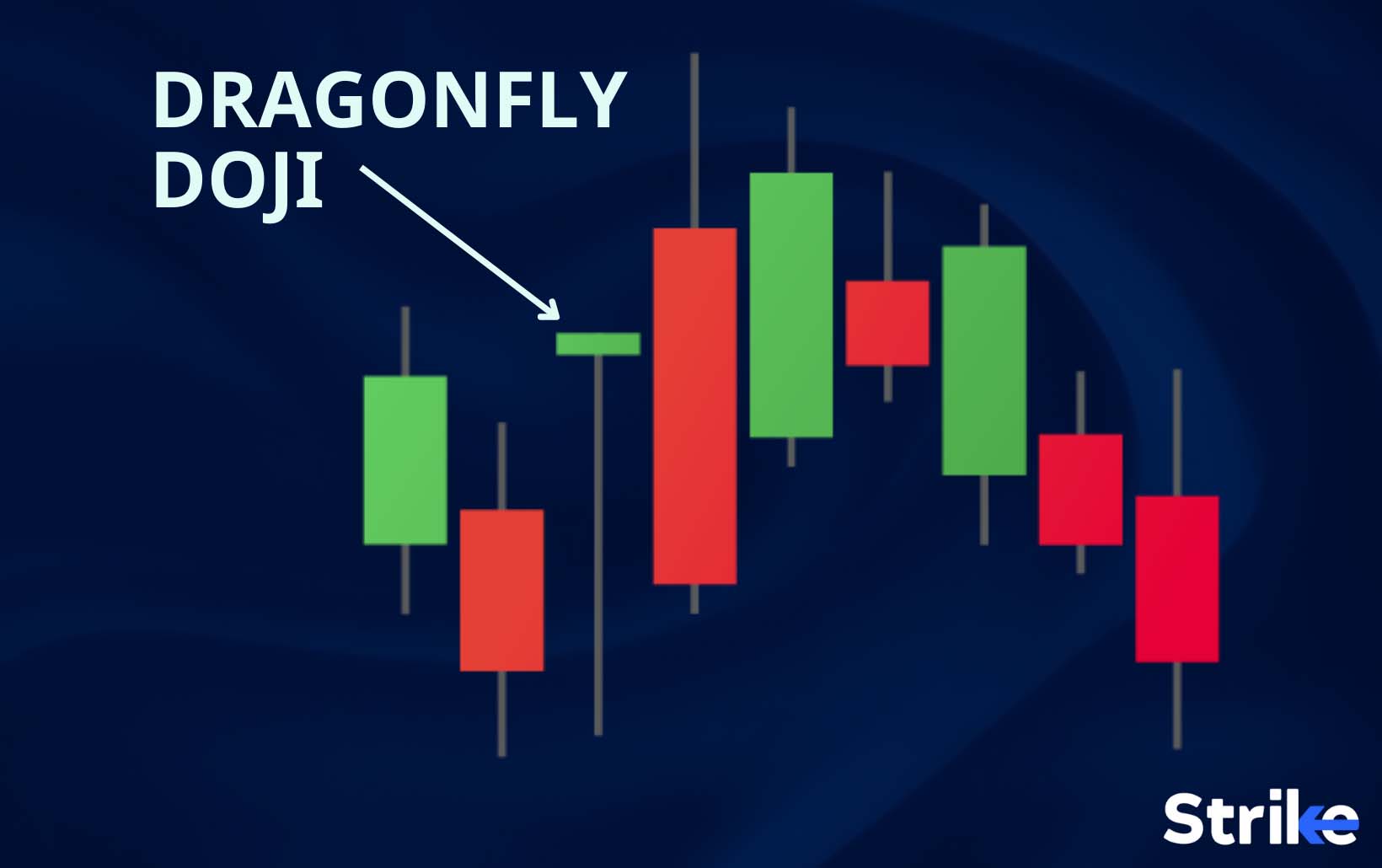
Dragonfly Doji is a candle pattern with no real body and a long downward shadow. A Dragonfly Doji indicates a potential price reversal to the downside or upside, depending on previous price action. It occurs when the asset’s high, open, and close prices are uniform.
The long lower shadow indicates that there was some assertive selling during the timeframe of the candle. As the price closes near the open, the buyers absorb the selling pressure and push the prices back up.
The Dragonfly Doji candle is formed by any standard Doji candle with a very small body and a large shadow only on the lower side. The opening and closing prices are quite the same or similar because the body is small. The lower shadows are significantly longer than the candle’s body, which comprises the opening and closing prices. As a result, the low price is proportionately distant from the open, high, and close prices whereas the open, high, and close prices are comparable.
What precisely is a “Dragonfly Doji”?
A Dragonfly Doji is a candlestick pattern recognized by the open, high, and close prices that are equal or very close to one another, while the low price of the period is much lower than the previous three. The traders can quickly identify the “T” shape formed due to the lower shadow. The formation of a Dragonfly Doji after a price gain is a warning of a potential price decline. A move lower on the next candle gives confirmation.
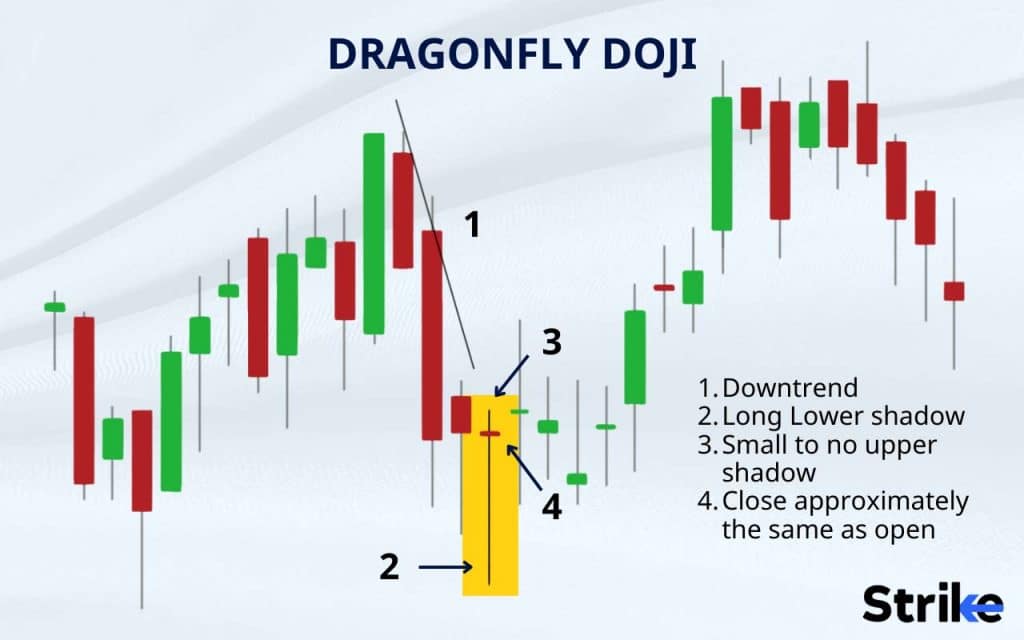
A Dragonfly Doji, after a price drop, warns that the price may rise. The rise of the succeeding candle provides the required confirmation for a price rise.
The Dragonfly Doji is a reliable sign of a trend reversal when it appears at the bottom of a downtrend. This is due to the price reaching a support level during the trading day, which suggests that the market’s sellers are no longer outnumbering the buyers.
A bullish movement may occur the next day if the asset is considered to be oversold, necessitating additional technical indicators. This may be an opportunity for additional entry points, particularly if the market opens higher the next day.
How is a Dragonfly Doji Candlestick Structured?
The body of a Doji candlestick is not rectangular. It has a cross-like shape since it is a rare kind with equal open and close prices.
Dragonfly Doji candlestick arises when a security’s open, close, and high prices are practically identical. A Dragonfly Doji is therefore T-shaped and has only a long lower tail instead of an upper tail.
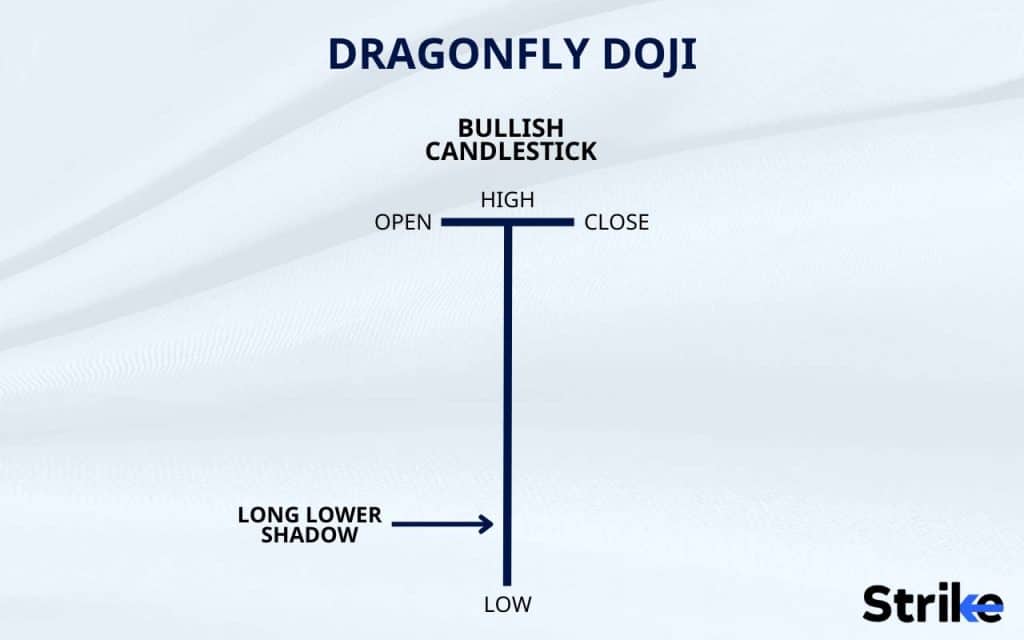
The long lower tail of a Dragonfly Doji signifies that the market has saturated with selling, which has caused downward pressure on the security price for a certain period.
What does Red Dragonfly Doji Candlestick indicate?
A red Dragonfly Doji forms when the closing price is slightly less than the opening price. This demonstrates that in the conflict between the bulls and bears, the bears dominate the market by a little margin. A red close signifies the weakness of the market.
What does Green Dragonfly Doji Candlestick mean?
A green close implies an uptrend. A green Doji pattern forms when the closing price of a stock is higher than the opening price. In this instance, the bulls were able to control the market slightly. This shows that the bulls are still somewhat confident in continuing their positions.
The formation of a green Doji can signal that the market may pivot from this point, in case it has been in a continuous downtrend during the previous trading periods. The occurrence of a green Doji during an uptrend indicates that the stock is about to break out.
Do the Color of Dragonfly Doji Matter?
No, the color of the Dragonfly Doji does not matter. It can be either green or red because the opening and closing prices have a close resemblance. The traders, however, follow the confirmation candle method. They usually monitor the shade of the confirmation candle as that trend is expected to continue. A green confirmation candle signifies an uptrend whereas, a red confirmation candle denotes a downtrend.
When does Dragonfly Doji Candlestick occur?
A Dragonfly Doji occurs when the buyers in the market have successfully pushed the session’s candle from the session’s low, back to the session’s open price.
The Dragonfly Doji is a candlestick pattern that occurs when the high, open, and close prices are equal, or nearly similar, while a long wick has created a session low. A wick is a line used to show where the stock’s price has fluctuated to its opening and closing prices.
This long lower wick indicates that sellers sold actively during the timeframe of the candle. Price was able to bounce back and close near the high since the candle closed near the open.
The action can be more significant depending on the length of the wick. The longer the wick, the more effective the action.
How often does Dragonfly Doji Candlestick happen?
A Dragonfly Doji pattern doesn’t occur very often, but when it does, it warns that the trend may change.
The Dragonfly Doji, following a price advance, indicates that sellers were able to gain control for at least some part of the period. The candle following a likely bearish dragonfly needs to confirm the trend reversal. The candle that comes after must drop and close below the dragonfly candle’s close. The reversal signal is void if the price increases on the confirmation candle since the price may continue to rise.
The Dragonfly Doji, following a price decline, indicates that the sellers were present early in the time, but towards the end of the session, the buyers had lifted the price back to the open. This suggests additional buying pressure during a downtrend and could anticipate a price gain. The signal is validated if the candle following the dragonfly raises, closing above the dragonfly’s close. The reversal is more reliable if the rally is more substantial on the day following the bullish dragonfly.
How to read Dragonfly Doji Candlestick in Technical Analysis?
Technical analysts look for the pattern to develop after a setback in an uptrend because it signals a shift in buying pressure and a potential end of the pullback. Analysts may initiate a long position when the Dragonfly Doji pattern develops by purchasing the security and holding it until it hits a target price. Some traders may also establish a stop-loss order, to reduce potential losses in case the trend does not reverse as anticipated.
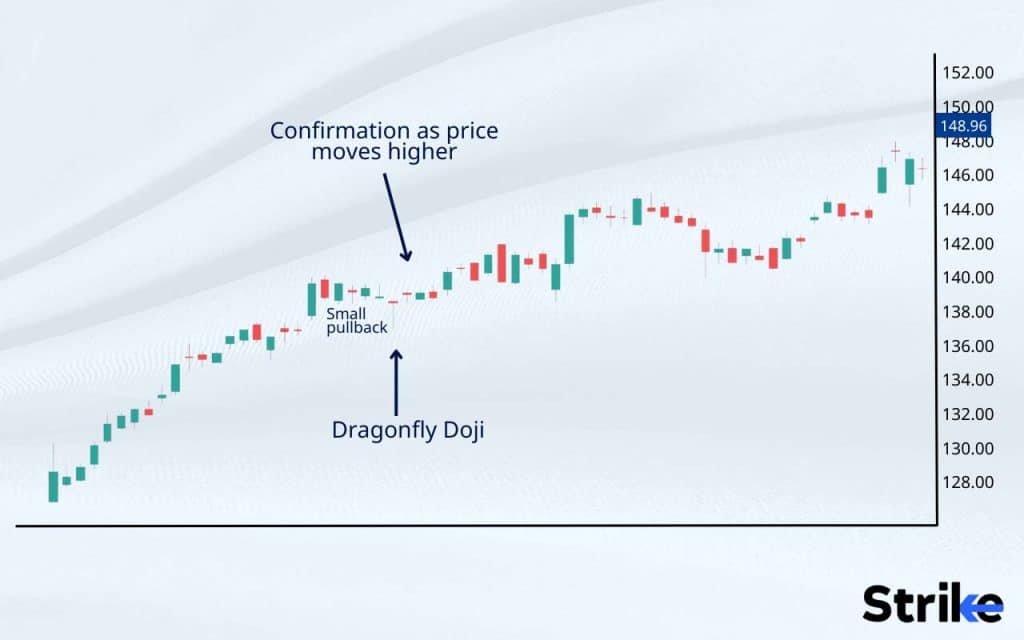
Analysts should keep in mind 5 key points while reading a Dragonfly Doji pattern.
First, they should look out for a downtrend, as the pattern is more significant when it appears in a downtrend indicating a trend reversal during technical analysis.
Secondly, technical analysts should consider a long lower shadow as it indicates that the price fell noticeably during the day, but the buyers were able to push it up again creating a long lower shadow.
After that, the third important point is to look for a small or non-existent body implying minimal price movement during the day and opening and closing prices near to each other.
The fourth important point to keep in mind is that there must be no upper shadow present. No upper shadow suggests that the price was unable to advance higher during the day and that there was significant resistance at the high of the day.
Lastly, one must consider that the Dragonfly Doji is only one type of price pattern, it should be utilized in conjunction with other research techniques and the overall market environment to help traders make well-informed trading decisions. Certain traders may use other technical indicators like stochastic, RSI, and volume analysis to confirm a likely price reversal.
How accurate is a DragonflyDoji Candlestick in Technical Analysis?
A Dragonfly Doji with high volume is more accurate than a relatively low-volume one typically. The confirmation candle must also show a strong price movement and volume.
The accuracy of the Dragonfly Doji pattern, however, depends on factors like the framework of the pattern, the time range of being analyzed, and other technical indicators.
How effective is a Dragonfly Doji Candlestick in Technical Analysis?
In technical analysis, a Dragonfly Doji candlestick pattern indicates that buyers and sellers in the market are unsure of their positions. This indicates that neither bulls nor bears will have a clear advantage in the near-term market.
Like all other candlestick patterns, the Dragonfly Doji should not be applied alone. Combining it with other technical and price action tactics is the best way to use it.
Where does a Dragonfly Doji Candlestick Pattern is commonly used?
The Dragonfly Doji candlestick pattern is usually employed in the technical analysis of financial markets, like stocks, forex, and commodities. The Dragonfly Doji is used to spot possible reversals and appears when the open and closing price of a stock’s day range is almost similar.
Dragonfly Doji also helps traders to spot support and resistance levels.
Traders and investors use Dragonfly Doji to set stop-loss levels to limit their losses.
How to Trade with Dragonfly Doji Candlestick in Stock Market?
To employ a Dragonfly Doji for stock trading, you must have a solid trading method incorporating the pattern into its signaling system rather than using it as a stand-alone signal. The simple price action strategy for using Dragonfly Doji in the stock market is to identify the trend and proceed accordingly.
- Identify the trend: Refer to an upward trendline to identify the direction of the trend. The price must be above the trendline and there must be an upward trend.
- Identify the levels of support below the price: Draw a horizontal line to identify the probable support levels.
- Recognize the pattern: Look out for the Dragonfly Doji pattern around the marked support level.
- Place a buy order: Place a buy order at the opening price of the following candle after verifying the Dragonfly Doji pattern at a support level.
- Fix a stop loss: Set a stop loss order below the low of the Dragonfly Doji pattern to reduce risk.
- Decide on a profit target: Set a profit target before the next resistance.
- Monitor the stock trade: Regularly analyze the stock to see whether the price starts to rise or the stop loss is activated.
Dragonfly Doji is an important indicator that is employed by traders in the stock market, however, it is not 100% reliable and must be used in combination with other technical indicators like RSI, moving averages, etc.
When is the best time to Trade using Dragonfly Doji Candlestick?
The best time to trade using a Dragonfly Doji is after a pullback in an uptrend. Traders watch for the pattern to develop after a pullback in an uptrend because it signals a change in purchasing pressure and the potential end of the pullback.
What is an example of a Dragonfly Doji Candlestick used in Trading?
Let’s take an example where a bullish Dragonfly Doji follows a medium-term downtrend. Long positions can be taken after a subsequent bullish closing period serves as proof for the trigger signal. Expert traders frequently start positions immediately after the close of the price candle that follows. This assists in avoiding false breakout signals, which can quickly lead to excessive losses. Stop-loss orders are positioned below the price low of the pattern when taking long bets on a bullish Dragonfly Doji reversal.
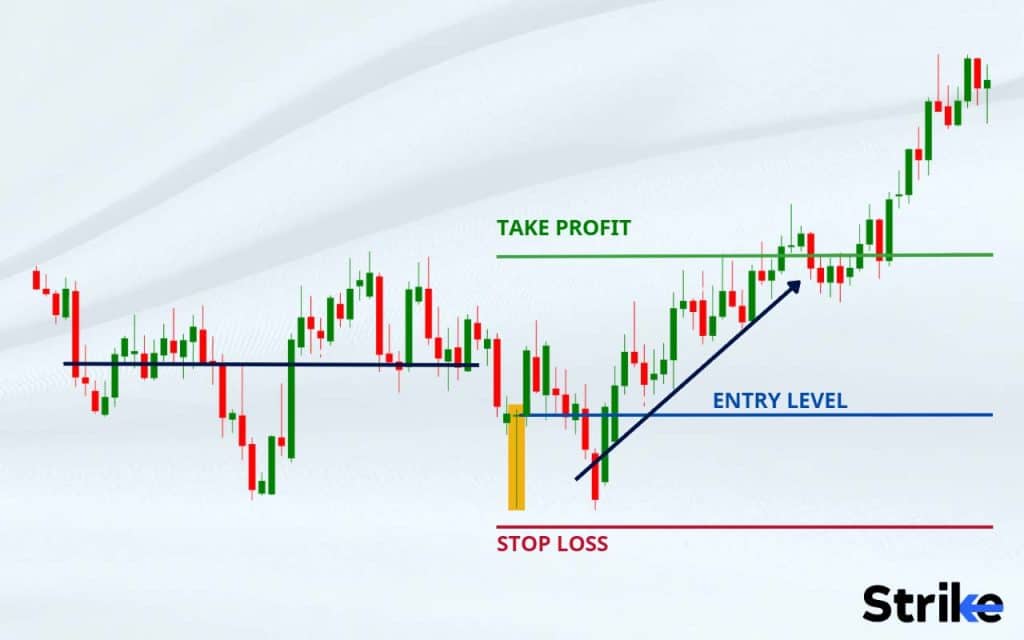
Is a Dragonfly Doji An Uptrend Sell Signal?
Yes, Dragonfly Doji is considered an uptrend sell signal most of the time. The Dragonfly Doji functions as a reversal 50% of the time based on how it behaves in the market. As a result, it is neither an uptrend sell nor a downtrend sell signal candle. It stands for uncertainty. As the closing price is set at the top of the candlestick and the lower shadow is so long, upward breakouts are more common.
Is a Dragonfly Doji Candlestick a Dragonfly Doji Bullish or Bearish?
The Dragonfly Doji is bullish. A Dragonfly Doji means that the price opened at the session high. The price had a significant decrease during the session before closing at its peak. The result is that the price at open, high, and close is all the same (or nearly equal) and the low is significantly lower.
It implies that the sellers initially had the upper hand but the buyers stepped in and raised the price back up to the open level, signifying a potential bullish market sentiment.
What are the Benefits of a Dragonfly Doji Candlestick?
The pattern typically indicates indecision in the market, and it can have several benefits for traders as it helps traders to make trading decisions and acts as a reversal signal. It also helps determine the entry and exit points.
- Acts as a reversal signal: A Dragonfly Doji may be a sign of a price reversal. A downward trend in a security’s price may indicate an upcoming price increase. In this instance, the dragonfly is bullish. The price reversal is confirmed and trading decisions can be made if the candlestick that opens immediately following the bullish dragonfly increases in price and closes at a higher price.
- Helps make trading decisions: A Dragonfly Doji can be used by traders to guide their trading choices. Usually, they start placing orders as soon as the confirmation candlestick emerges. A trader may choose to long a stop loss below a bullish dragonfly’s low or short a stop loss above a bearish dragonfly’s high.
- Helps to determine entry and exit points: The Dragonfly Doji can be used by traders as a signal to enter or exit a position. For instance, if a Dragonfly Doji appears following a protracted rise, it may be a sign to sell as it suggests that the buyers may be losing momentum.
Overall, the Dragonfly Doji is beneficial for traders to make informed trading decisions by indicating stop loss level and trend reversal pattern.
What are the Drawbacks of a Dragonfly Doji Candlestick?
Dragonfly Doji candlestick has numerous benefits, but it also has certain limitations like not being a reliable indicator, not providing adequate entry points, and not providing price targets.
- Not being a reliable indicator: The Dragonfly Doji does not occur frequently, but price reversal happens regularly. Thus, the Dragonfly Doji is not a very accurate indicator of price reversals. Generally, a Dragonfly Doji with a higher volume than one with a lower volume is more reliable. It holds true for the confirmation candlestick as well.
- Not providing adequate entry points: The size of the dragonfly along with the size of the confirmation candle sometimes indicates that the entry point for a trade is far away from the stop loss location. This means traders require to find another point for the stop loss, or they might need to cancel the trade since a stop loss that is too large may not justify the possible benefit of the trade.
- Not providing price targets: The Dragonfly Doji pattern cannot provide price targets. It is difficult to predict the return of a trade that is made only according to Dragonfly Doji analysis. Traders need to use additional technical indicators to identify the ideal time of exit.
Dragonfly Doji has drawbacks like trading based on the Dragonfly Doji pattern may result in higher trading expenses, which can reduce profits. However, they can prove to be beneficial when used wisely.
What are other types of Doji Candlestick Patterns besides Dragonfly Doji?
There are 6 other Doji candlestick patterns besides Dragonfly Doji. They are Gravestone Doji, Long-Legged Doji, Star Doji, Bearish Doji Star, Bullish Doji Star, and, Hammer Doji.
- Gravestone Doji: The Gravestone Doji is created by inverting the Dragonfly Doji upside down. The prices at the opening, low, and close are essentially the same, while the price at the high point is much greater. Buyers were active early on, but by the close, they would have lost all their profits, and sellers had pushed the price all the way down to the open.
- Long-Legged Doji: A long-legged Doji is a result when the open and close prices are nearly equal but there are sharp highs and lows during the period, lengthening the tails. A long-legged Doji pattern denotes uncertainty because neither the bulls nor the bears advance significantly within the time frame, despite considerable moves in both directions.
- Star Doji: There are two distinct star Doji candlestick patterns: a bullish Doji star and a bearish Doji star. Both develop after an upward or downward trend in the price of an asset and aid in indicating various trend directions.
- Bearish Doji Star: A bearish Doji Star develops after an uptrend. It looks like a plus sign. The bearish reversal of the Doji star is confirmed if the price declines after the candle pattern. The body of the bearish Doji star should occur higher than the previous candle.
- Bullish Doji Star: A bullish star Doji, sometimes referred to as a morning star Doji shows up as a positive sign following a decline. The pattern is verified if the price rises higher after the bullish start of Doji. Its body should be lower than the previous candle.
- Hammer Doji:The hammer-shaped Doji candle appears after a price decline and takes its name from its shape. A hammer Doji candlestick forms when the price rises initially and then declines before closing near the opening price. The pattern suggests that buyers are flooding the market when prices are at their lowest.
These Doji patterns other than Dragonfly Doji makes trading easier for traders in the stock market.
What Candlestick Pattern is Similar to Dragonfly Doji Candlestick?
The Dragonfly Doji pattern and the hammer Doji pattern have a lot in common. The Hammer pattern, which has a small body and a long lower shadow, is formed near the bottom of a downtrend, just like the Dragonfly Doji. Similar to a Dragonfly Doji, hammer formation shows the combination of selling pressure and buying pressure with an open and close that are at or near the day’s high and a low that forms a long tail.
What is the Opposite of Dragonfly Doji Candlestick?
The Gravestone Doji is the opposite of the Dragonfly Doji. It emerges when price movement opens and closes at the lower end of the trading session. A Gravestone Doji is a bearish reversal candlestick pattern that is created when the open, low, and closing prices are all close to each other with a long upper shadow.
What is the difference between Dragonfly Doji and a Hammer Candlestick?
The open, high, and close prices in the Hammer pattern are typically not identical, however, in the Dragonfly Doji pattern the open, high, and close prices are nearly the same. The Hammer pattern is considered a bullish indication, indicating that buyers have entered the market to support and raise the price.
The main difference between the Dragonfly Doji and hammer Doji is that the former opens and closes at the same place whereas, the latter opens lower and closes slightly below the opening price.
A Dragonfly Doji is typically a more accurate indicator of a reversal.


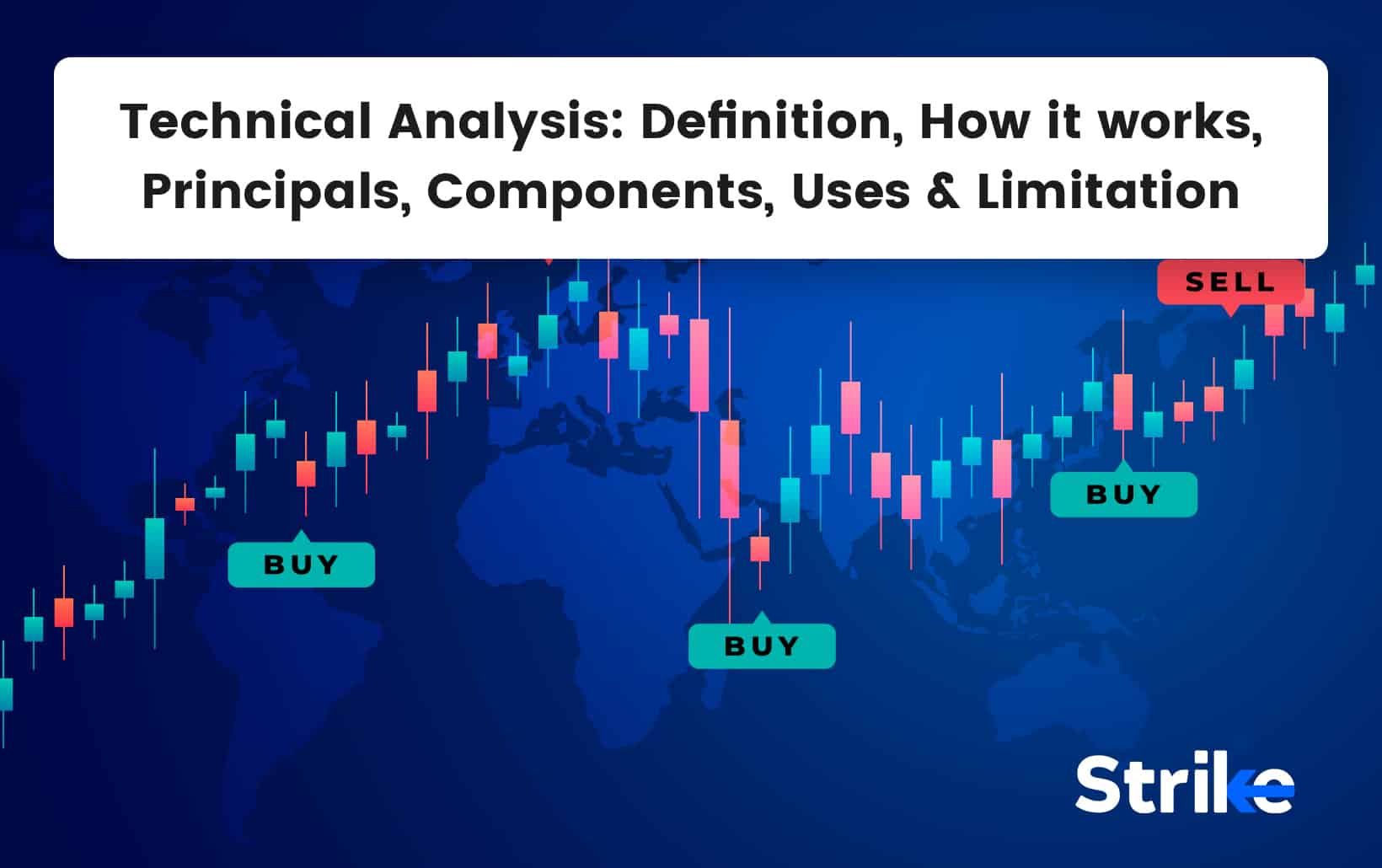
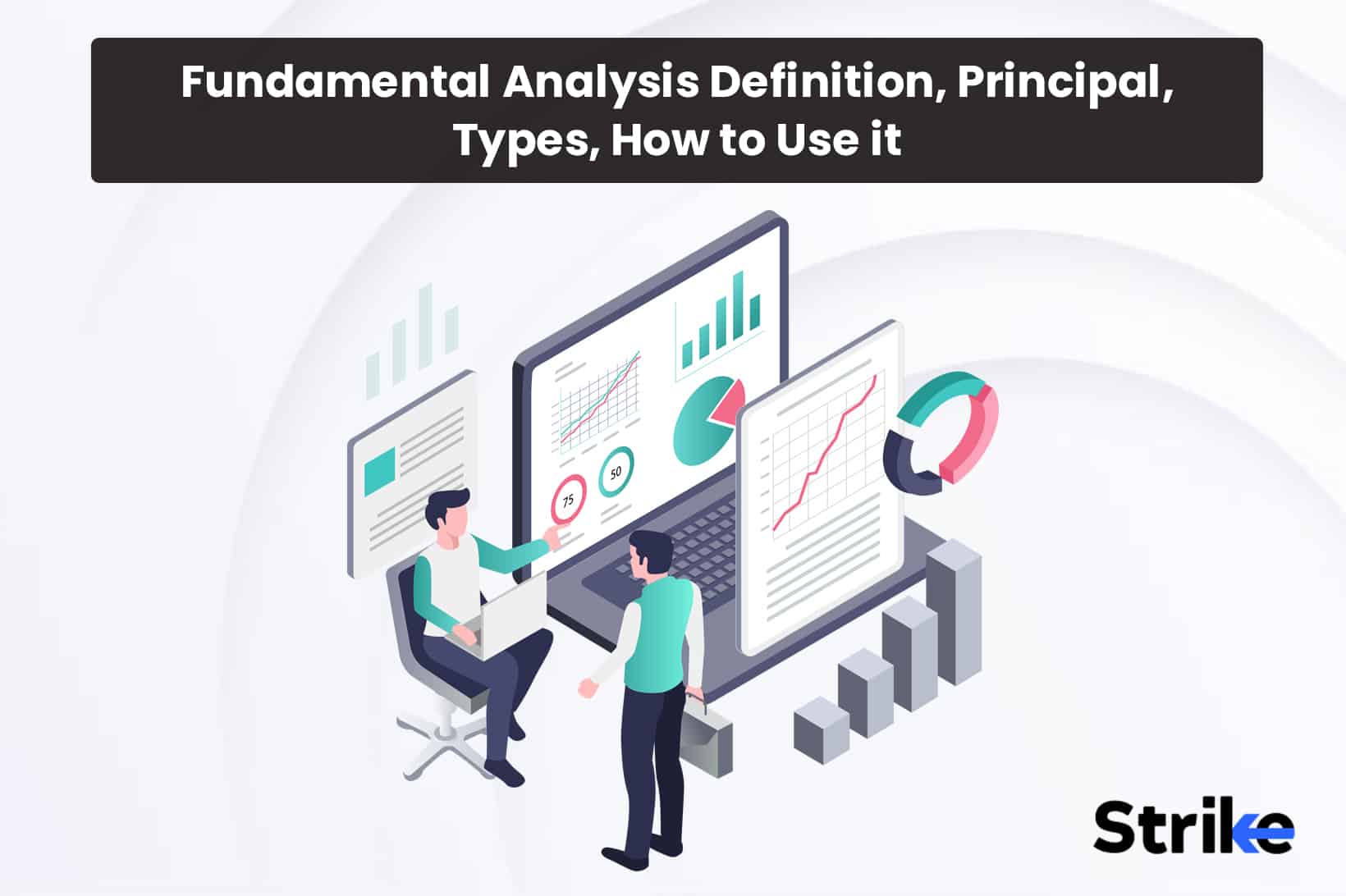


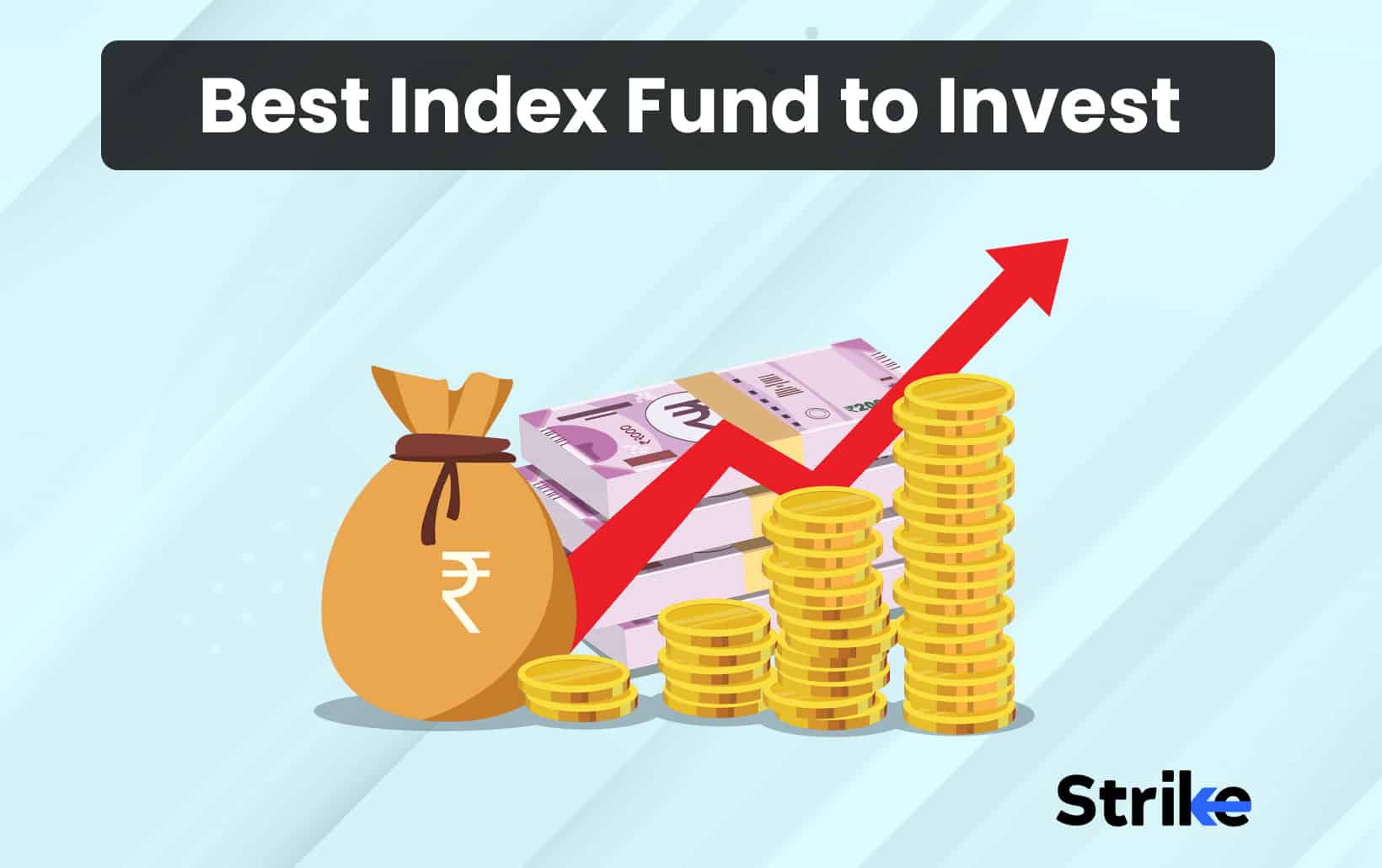




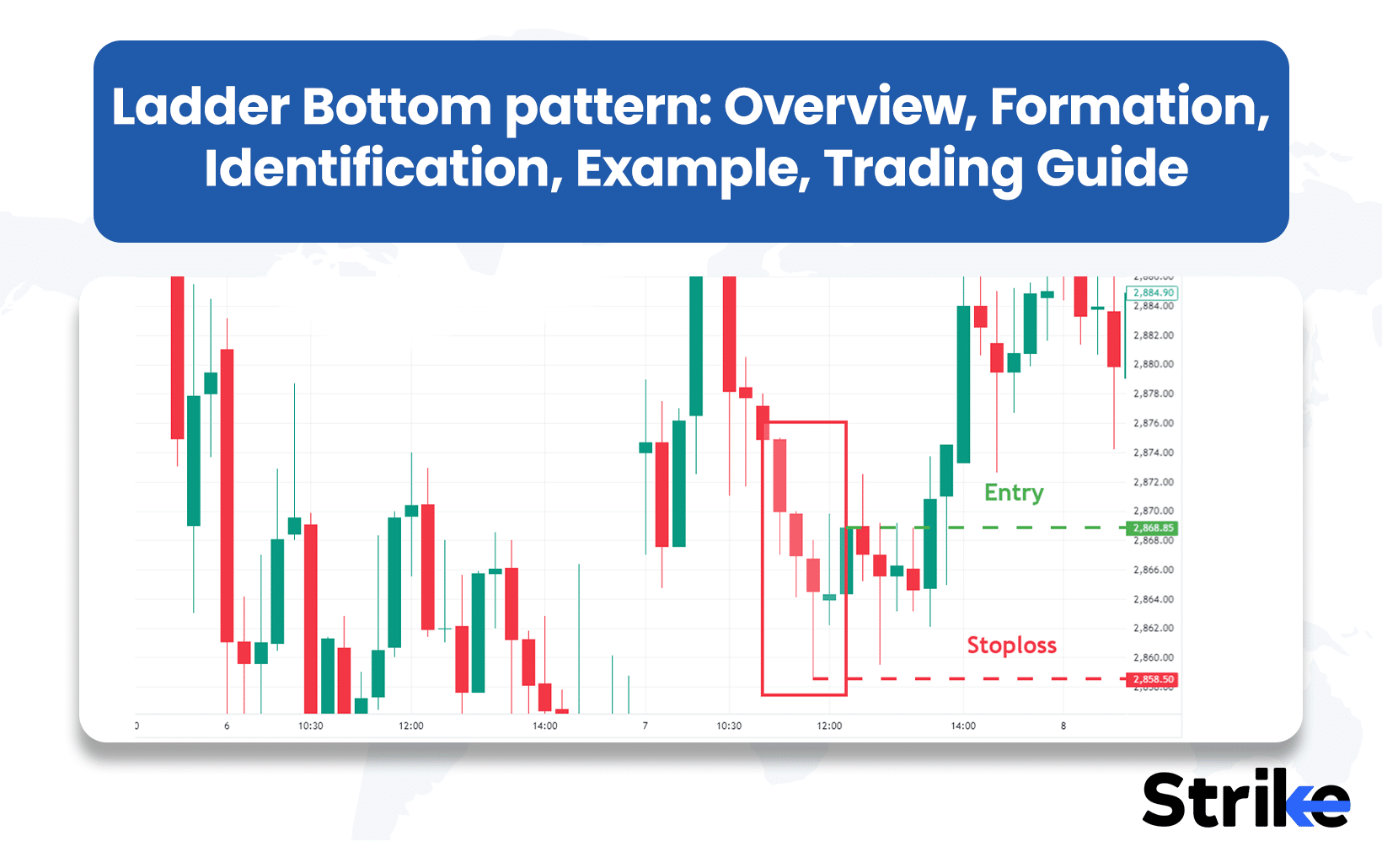




No Comments Yet.